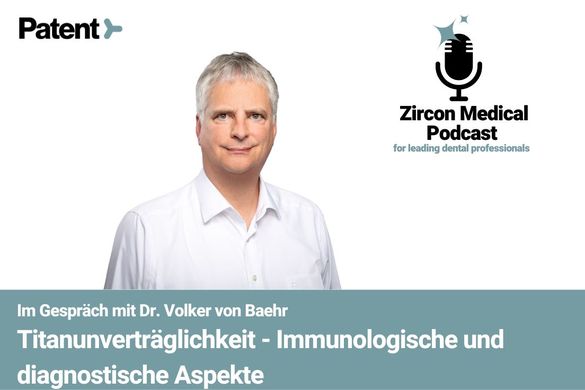
Introducing Dr. Volker von Baehr, the medical director of the Institute for Medical Diagnostics in Berlin
Understanding titanium intolerance and allergies
The link between titanium implants, periodontitis, and peri-implantitis
The possibility of titanium oxide particles migrating to other parts of the body
Titanium intolerance — risk factor, not an allergy
Consequences of titanium intolerance
Tests for titanium intolerance — genetic test and functional test
Immunological response to zirconium dioxide implants
Dr. Volker von Baehr
Medical Director of the Institute for Medical Diagnostics Berlin
Nicolaistraße 22, 12247 Berlin, Germany
In Conversation with Dr. Volker von Baehr
Over the past decades, there has been growing concern within the dental community about the long-term safety and stability of titanium implants. It has become increasingly clear that titanium implants increase the risk of toxicity and peri-implant complications. Titanium has been the material of choice for implants for decades, but it’s become clear that ceramic (zirconium oxide) should be the gold standard moving forward.
Our Zircon Medical Podcast recently hosted Dr. Volker von Baehr, the medical director of the Institute for Medical Diagnostics in Berlin, to better understand how titanium implants affect the human body and overall health.
Introducing Dr. Volker von Baehr, the medical director of the Institute for Medical Diagnostics in Berlin
Dr. Volker von Baehr has been the medical director of the Institute for Medical Diagnostics in Potsdam, Berlin, since 2002. He specializes in special diagnostics within the field of clinical immunology, which deals with all chronic inflammatory diseases related to the immune system. His field of expertise ranges from allergy diagnostics to the diagnostics of autoantibodies, chronic inflammation, intolerances, and certain genetic tests.
Dr. Von Baehr’s task at the Institute for Medical Diagnostics is to guide 360+ employees, including 20 natural scientists who manage the analytical departments. He supervises and spearheads the entire research and development process, including the routine laboratory operation. He says diagnostic laboratories like IMD were developed because of increasing pressure from doctors and dentists for more information on immunology.
Understanding titanium intolerance and allergies
Dr. von Baehr’s laboratory performs extensive research on titanium incompatibilities. He emphasizes the difference between titanium intolerance and allergies. There are different types of allergies — classical hay fever is different from an allergic reaction to nickel or metal ions. There are also different mechanisms and reactions that occur within organisms. The term “allergy” is simply a collective term that refers to a wide range of reactions and bodily responses.
Dr. von Baehr identifies two primary types of allergies — the standard hay fever-type of allergy and the cellular T-lymphocyte mediated allergy (including metal allergy). But titanium is a special metal that isn’t ionized like other metals, and it can’t change the body’s proteins. Instead, titanium oxidizes easily and releases abrasion particles, which triggers an intensified foreign body reaction, which can refer to as titanium hypersensitivity.
The body’s reaction to titanium has nothing to do with classical forms of allergies, such as food and nickel allergies. Quite simply, all titanium implants release titanium oxide particles that induce certain reactions in the human body. But some people simply react more violently to the titanium oxide particles, leading to the symptoms of titanium intolerance.
Dr. Von Baehr also clarifies that there’s nothing pathological about a patient exhibiting harsh symptoms in response to the titanium oxide particles. The intense inflammation is simply a result of the individual’s immune system having a strong foreign particle reaction, reliant upon the same functions that ward off harmful bacteria. But the problem with titanium is that the particles exist in an area unfamiliar to the immune system.
If the titanium oxide particles were released in the oral cavity or the intestine, there would be no problem because the immune system is accustomed to foreign bodies in these regions. But when an implant is placed in the body, specifically the immune cells of the bone, the immune system tries to eliminate the titanium oxide particles, absorb them, and produce inflammation.
Some patients exhibit more inflammation, which is counterproductive to optimal healing.
The link between titanium implants, periodontitis, and peri-implantitis
In principle, Dr. von Baehr says the body’s defense reactions against bacteria and titanium oxide particles are similar. The body relies on the same immunological mechanisms to eliminate harmful bacteria and titanium oxide particles. Even though the body can’t eliminate all the titanium oxide particles, the immunological mechanisms are the same.
The specific immune cells (lymphocytes) selectively attack certain antigens and allergens, but the non-specific phagocytes eliminate all unwanted foreign particles, such as bacteria. When it comes to harmful bacteria, the immune cells can successfully eliminate them, though the patient may experience inflammation. But the immune cells can’t eliminate titanium oxide particles, so the unwanted particles are simply absorbed into the cells.
But the immune system has a hard time coping with titanium oxide particles. In Dr. von Baehr’s words, “the immune cells are crying out for help because they have absorbed something that they can’t cope with, and this call for help is particularly strong in 10% to 15% of the population, who experience increased inflammation to bacteria and titanium. The same prediction mechanisms can be made for an increased risk of periodontitis and peri-implantitis.”
Ultimately, Dr.von Baehr states that the same immunological functions are responsible for periodontitis and peri-implantitis. In the case of periodontitis, the immune cells try to fight off and eliminate harmful bacteria, and in the case of peri-implantitis, they try to eliminate titanium oxide particles. Consequently, individuals with a higher risk of periodontitis also have a higher risk of peri-implantitis.
The possibility of titanium oxide particles migrating to other parts of the body
Titanium dioxide is a non-degradable material, so the immune system can’t break down and eliminate the titanium particles. But the immune system can successfully disperse the titanium particles from the implant and into the wider tissues. Some studies on animals have also shown the presence of titanium particles in regional lymph nodes, which indicates that the particles have distributed. But in most cases, the inflammation is localized to the mouth.
Dr. von Baehr clarifies that the dispersion of titanium particles is a local problem, and the inflammation primarily occurs in the mouth. But he states that one cannot exclude the possibility that titanium oxide particles are located somewhere in the lymph nodes, as found during animal experiments.
Dr. von Baehr cites the example of nickel and drug allergies when discussing how titanium oxide particles and inflammation may spread to other parts of the body. The inflammatory reaction from nickel allergies can spread to other areas, leading to eczema on the skin and other problems. But titanium oxide particles are usually too large to pass through the blood vessel walls and tissues, so the risk of systemic connections to other parts of the body is low.
Titanium intolerance — risk factor, not an allergy
Dr. von Baehr says he compares the risk of titanium implants to smoking. It’s clearly understood that smokers have a higher rate of peri-implantitis than a non-smoker. And similarly, 15% of patients have a higher risk of developing a severe reaction to titanium implants than others. But the same standard doesn’t apply to everyone. Some smokers also heal very well, and some patients with a higher risk of titanium hypersensitivity may not experience harsh inflammation.
The risk of titanium oxide particle hypersensitivity isn’t a compelling contraindication, so it’s not generally tested by most dentists. But the attitude is changing, and more dentists and doctors are starting to perform tests for titanium oxide particle hypersensitivity to ensure better results and improve their success rates. The new ABV guideline in Germany also states that titanium intolerance is a pathological mechanism that can be determined via genetic analyses or titanium stimulation tests.
Consequences of titanium intolerance
Patients with titanium intolerance usually experience increased local inflammation, eventually leading to peri-implantitis or an immediate loss of the implant. Other possible consequences are mucosal inflammation, bone resorption, delayed bone formation, and delayed healing, all of which have been proven through numerous clinical studies. However, there are also cases wherein the patient heals perfectly and experiences no problem, so it’s just a risk factor — not a contraindication.
Tests for titanium intolerance — genetic testand functional test
Dr. von Baehr says there are two possible tests for titanium oxide particle hypersensitivity — a genetic test and a functional test.
The genetic test examines some of the relevant genetic constellations, which indicates whether the patient is a high responder or a low responder, depending on the explosiveness of the inflammatory response. The high responders have a very explosive inflammatory response, which is unfavorable for healing. The potential severity of inflammatory response is categorized from Grade 0 to Grade 4, with Grade 4 patients having the highest risk. The genetic test isn’t 100% accurate because the inflammation may also happen because of other genes.
The functional test is cheaper than the genetic test. The functional test involves taking blood from the patient to mature and isolate the macrophages, i.e., cells that are similar to osteoclasts and stimulated in the laboratory with titanium dioxide. The doctor places sterile titanium on the patient’s cells, which may induce a weak, moderate, or strong inflammatory response. The functional test can also be inaccurate because the cells might be pre-stimulated by momentary events, which can lead to increased inflammation.
A genetic test is usually considered the superior method because the results can’t be influenced by momentary conditions.
Dr. von Baehr says most orthopedic surgeons and dentists have, up until recently, avoided tests for titanium hypersensitivity because of the lack of alternatives. If the patient needs an implant and there are no other solutions, then the doctor must rely on titanium implants. But if an alternative is available, such as ceramic implants, the doctor can perform a hypersensitivity test to determine if a ceramic implant might be more suitable for long-term health.
Immunological response to zirconium dioxide implants
Dr. von Baehr says zirconium dioxide particles lead to minimal or no abrasion in patients. Ceramic implants have fewer abrasionparticles than titanium implants. If the same size of titanium oxide particles and zirconium oxide particles are placed in the same patient, the titanium oxide particles will inevitably produce more inflammation. That’s why zirconium oxide particles are considered to be safer for patients than titanium oxide particles.
Immunologically, zirconium oxide is an excellent material for implantation because it poses a minimal challenge to the immune system. That’s why ceramic implants lead to beautiful soft tissue healing and results — the inflammatory stimulus is barely present.
But until recently, the inability of ceramic implants to challenge the immune system has also been a problem. The immune system must challenge the implant a little to stimulate natural bone regeneration. The inflammation needs to simply be controlled. If there’s no immunological response or inflammation, the bone will not grow, leading to implant instability. That’s why early ceramic implants have had problems with osseointegration and healing.
However, over the years, the surface of ceramic implants has undergone significant changes. The surfaces of ceramic implants aren’t similar to titanium implants, but they have a certain roughness (due to macrophages) that triggers the immune system to facilitate bone regrowth. Some of the modern ceramic implants strike the perfect balance — they induce just enough inflammation and immunological response to facilitate bone regrowth but not enough to cause complications.
For more information on the immunological aspects of titanium intolerance, you can visit the official website of The Institute for Medical Diagnostics in Berlin. You can also listen to Dr. von Baehr on the Zircon Medical Podcast.





